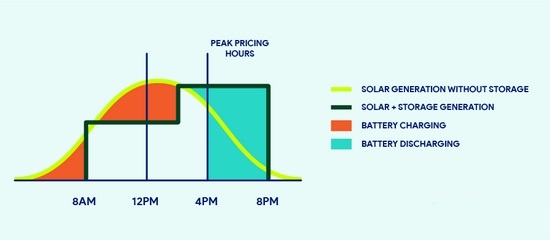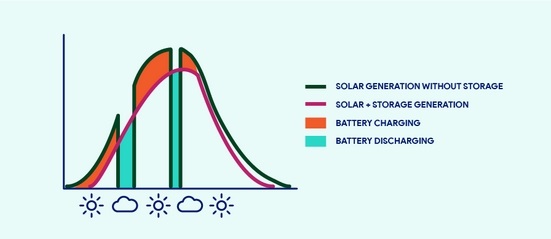Nowadays, some renewable energy developers are deploying energy storage systems to their operational solar power facilities to save a significant amount of electricity costs. Here are three reasons for the deployment of battery energy storage systems for solar power facilities:
Reason 1: Solar power systems with battery storage have power available when most needed, even on cloudy days
Most utilities offer time-based electricity rates for commercial and industrial (C&I) users, which means users have to pay higher electricity costs when the grid is supplying power at peak capacity. For utilities during peak summer periods, the late afternoon is typically the most profitable time.

By deploying battery energy storage system as a complement to solar power facilities, a portion of the facility’s power can be stored during times of lower electricity prices and discharged during times of higher prices to meet peak demand. This is called energy shifting and it is a good way to improve the return on investment of solar power facilities, as shown in the blue area in the upper right quadrant of the above diagram.
Reason 2: Expanding the generation capacity of solar power facilities
For utilities without battery storage systems deployed alongside their large-scale solar power facilities, there is a limitation: the solar power facility can only generate as much as the transmission line and grid can accommodate.
The same applies to commercial and industrial users who have installed solar power facilities – they can only use as much of the facility’s electricity as possible. Again, there is a limitation that may require them to still rely on grid power during certain periods of the day, while these users may prefer to use their own low-cost clean energy.

By adopting battery storage systems, excess generation beyond the grid’s capacity can be stored, allowing for the opportunity to install larger solar power facilities and gain more value from their investments, as shown in the above diagram.
Reason 3: Managing interruptions and grid outages
Electricity moves at nearly the speed of light, which means that if it is not stored, it will be used or wasted at the same moment it is generated. Therefore, the production and consumption of electricity must be balanced. If not, the imbalance of supply and demand can cause voltage drops and spikes in the grid, which can damage many electrical equipment used by industrial facilities.
Solar power generation can also be affected by weather issues, leading to a decrease in generation. If electricity demand does not decrease, it can affect load operations.
The combination of solar power facilities and storage systems allows for adjustments in generation capacity due to weather-related generation fluctuations. The process of managing deviations in solar power generation caused by adverse weather conditions is known as “smoothing solar power generation”.
Solar power systems with battery storage also enable users to disconnect their facilities from the grid and keep their equipment running during scheduled periods.

Users can benefit from the battery storage system paired with solar power facilities when they need power during times of lower solar power generation. This measure is called “energy firming”, which is the process of maintaining solar power generation within desired time frames. In other words, it ensures sufficient power is always available when users need it. Due to these three reasons, solar power facilities need to be deployed with battery energy storage systems.
